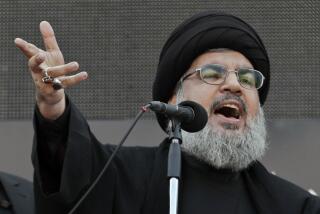ROLE MODELS FOR A TYRANT? : SADDAM HUSSEIN’S HEROES
- Share via
The Iraqi leader, who had controlled the world’s fourth-largest army, can now survey only the wreckage of his once-powerful military machine. In the face of increasingly certain defeat, why did he continue to refuse to give up? Part of the answer lies in the men he held up as his heroes--each ruthless and larger than life.
NEBUCHADNEZZAR
Saddam Hussein claims ancestral lineage with Nebuchadnezzar (approximately 605-562BC), the ancient king of Babylonia, who was known as a brilliant military strategist. In one of his biographies, Saddam said, “What is most important to me about Nebuchadnezzar is the link between the Arabs’ abilities and the liberation of Palestine . . . Nebuchadnezzar was the one who brought the bound Jewish slaves from Palestine. That is why, whenever I remember Nebuchadnezzar, I like to remind the Arabs--Iraqis in particular--of their historical responsibilities.” Nebuchadnezzar also was known for the reconstruction of the fortified city of Babylon, with its temples, palaces and the famed hanging gardens.
SALADIN
Saladin (1138-1193) was the medieval sultan who finally drove the Crusaders from the Holy Land in the 12th century. He was born in Tikrit, the birthplace centuries later of Saddam Hussein. Saddam dreams of uniting the Arab nations as Saladin did in the Muslim world. Between 1174 to 1186, Saladin combined remarkable diplomatic and military skills to pursue his goal of uniting all the Muslim territories of Syria, northern Mesopotamia, Palestine and Egypt. While Saladin became an honored Muslim hero, his conquests invited a second Crusade by European armies under the leadership of English King Richard the Lion Hearted. The Crusade accomplished little except the capture of the Mediterranean city of Akko. Saladin died in Syria. About Saladin’s quest, Saddam is quoted in one biography as saying: “By God, I do indeed dream and wish for this. It is an honor for any human being to dream of such a role.”
STALIN
Josef Stalin (1879-1953), the ruthless and feared Soviet dictator, built his support within the Soviet Communist Party in a manner that Saddam Hussein is said to view as a model for Iraq’s Baath Party. He transformed communism from an egalitarian revolutionary movement into a brutal, repressive regime that enforced the collectivization of the land and industrialization. Under Stalin, the Soviet Union became a major ally against Germany in World War II and, following the war, Stalin established rigid communist regimes throughout eastern Europe. Stalin brooked no opposition. Millions died in labor camps and famine. Years after his death, Stalin’s deeds of terror were openly publicized. In Iraq, the Baaths also forged power through terrorism and persecution. Saddam said he believed that Stalin’s economic policies to develop a modern industrial society could be successfully applied to Iraq.
NASSER
Gamel Abdel Nasser, president of Egypt from 1956 until 1970 is revered throughout the Arab world. He appeals to Saddam Hussein in particular for his attempts to unify Arabs. As an army officer, he led a coup against King Farouk in 1952, and by 1956 became president under a new constitution which gave Egypt a one-party political system. He led a repressive regime in which all opposition was crushed. Still, as the first true Egyptian leader of his country in almost two thousand years, he became a powerful symbol of Arab pride. It was Nasser who nationalized the Suez Canal, built the Aswan High Dam with money from the Soviet Union, and joined with Syria to form the short-lived United Arab Republic. When Saddam fled from Iraq as a young revolutionary, it was Nasser who permitted him to stay in Eqypt. Nasser’s greatest humiliation came in 1967 when Israel destroyed the Egyptian air force and occupied the Sinai Peninsula in the Six-Day War. Nasser resigned but then heeded popular demand to remain president. He died in 1970.
Sources: Encyclopedia Brittanica; Encyclopedia Judaica; Faud Matar, “Saddam Hussein;” Samir al-Khalil, “Republic of Fear.”
More to Read
Sign up for Essential California
The most important California stories and recommendations in your inbox every morning.
You may occasionally receive promotional content from the Los Angeles Times.










